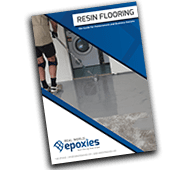Home › Advice › Know How › Knowhow
Hydrostatic Pressure and Moisture Tolerance
What is hydrostatic pressure and how is it related to moisture tolerance?
If you’re a regular visitor to this blog, you would’ve previously read about the benefits of choosing moisture tolerant epoxy hardeners when
it comes to avoiding amine blush (What is
amine blushing?).
But, does a moisture-tolerant
epoxy floor coating
mean I don’t have to be concerned by hydrostatic pressure? I’ve heard these terms creep into the same conversation many times and feel
as though it could end up down a dangerous path if one starts getting confused as the answer to the other. The answer is: no, they are
two different issues really.
The difference between hydrostatic pressure and moisture tolerance
Hydrostatic pressure is arguably the most complex, poorly understood of all preparation issues and a great example of why flooring can be a
tough gig. Not only is the issue itself a bit of a mystery, there also seems to be vagueness around the products used to fix it, and, as
we’re highlighting here, some related concepts such as moisture tolerance.
In brief, being moisture tolerant means the product doesn’t react badly to moisture during application, which is a very handy property
because you typically don’t have to worry about humidity in the air etc.
Hydrostatic pressure, on the other hand, is a powerful, destructive force that acts on a coating through the movement of water or water
vapour in the slab. Typically this pressure is caused by a moisture source close to the bottom of the slab, which, in the absence of an
effective moisture barrier below, sees water rise through the pores in the concrete. This migration becomes a problem in a coating sense
when it becomes trapped beneath an impermeable film sitting on the surface, at which point the build up of pressure can be sufficient to
blow sections off or cause other forms of damage like blisters.
You can probably see the relationship between moisture tolerance and hydrostatic pressure more clearly now; a moisture-tolerant product
might be able to handle application onto a slab with excess moisture, however this capability certainly doesn’t mean it will be safe from
the hydrostatic pressure acting on it once it hardens.

Hydrostatic pressure warning signs
If moisture tolerant products aren’t the answer to hydrostatic pressure, what is? Before we get into that, let’s take a look at how you can
diagnose such problems in the first place. Luckily, there are a few simple tests that can be used to spot hydrostatic pressure issues before
you go and put a coating down.
To start with, grinding a spot and seeing what colour it turns can be quite informative. If it starts to darken soon after, this is a classic warning sign that hydrostatic forces are at play. In this case you should also keep an eye out for efflorescence, which are visible marks that result from water coming to the surface and depositing silt-like substances as it dries.
A step up on those basic visual tests is to tape a 60cm x 60cm/2ft x 2ft plastic sheet to the concrete with duct tape and leave it for 24 hours. If water droplets appear on the underside of the plastic, or if the concrete appears darker in this area, your slab could have a problem.
For those after a more scientific approach, moisture meters can also be purchased to measure moisture levels at points on a slab and alert you to any potential problems. With this equipment, most people talk about 5-6% as being the maximum acceptable moisture content of concrete for flooring before hydrostatic issues are raised.
Personally, I’d never count on just one of these when assessing a slab. I’d look for multiple signs of a problem first and use that to guide my judgement on any action that needs to be taken.
Dealing with hydrostatic pressure
If your checks all point in the same direction and you do have a hydrostatic pressure issue, there are two common ways of dealing with it -
both of which look to create some form of water barrier to block it as it moves up through the slab.
Water-based epoxies are the first and probably the most common option here. These are typically 40-50% solids products that are applied onto
a pre-wet slab. As the epoxy is water-based, it thins down very quickly and penetrates deeply before crosslinking to form a barrier. Other
than that, there are also some colloidal silicate solutions that promote the ability to penetrate into the slab, reacting with the residual
lime and cement to form a gel barrier instead.
A couple of quick side notes about these treatments:
- Be careful when dealing with cracks as they may not consistently close off with these moisture barriers.
- In basements or other below-grade spaces, hydrostatic pressure can also be an issue on the walls and should be dealt with in the same way if they’re to be coated.
In closing, I just wanted to make the point this post should only be taken as a broad overview to raise awareness of hydrostatic pressure
and how it relates to moisture tolerance. As mentioned previously, hydrostatic pressure is a very technical, complex issue and further
reading is recommended for a full understanding.
-
Products - Use epoxy resins with genuine moisture tolerance to help avoid delays and failures on surfaces with
high levels of moisture:
- Jaxxon 1335 - Clear Epoxy Binder, Primer & Sealer
- Jaxxon 1505 - Industrial Epoxy Floor Coating
- Jaxxon 1525 - High-strength Industrial Epoxy Floor Coating
-
Learning - Learn more about the challenges of dealing with moisture in the substrate with our online courses:
- Epoxy Flooring Short Courses
- Bronze Card Course
- Silver Card Course
-
Ask a question - If you have any questions you'd like to ask us about this topic, hit the support button below:
_800x271a.png)
